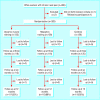Effectiveness of dynamic muscle training, relaxation training, or ordinary activity for chronic neck pain: randomised controlled trial
- PMID: 12946968
- PMCID: PMC188429
- DOI: 10.1136/bmj.327.7413.475
Effectiveness of dynamic muscle training, relaxation training, or ordinary activity for chronic neck pain: randomised controlled trial
Abstract
Objective: To determine the effectiveness of dynamic muscle training and relaxation training for chronic neck pain.
Design: Randomised controlled trial.
Setting: Five occupational healthcare centres, Tampere, Finland.
Participants: 393 female office workers (mean age 45 years) with chronic non-specific neck pain randomly assigned to 12 weeks of dynamic muscle training (n = 135) or relaxation training (n = 128), plus one week of reinforcement training six months after baseline; or ordinary activity (control group; n = 130).
Main outcome measure: Change in intensity of neck pain at three, six, and 12 months.
Results: No significant difference was found in neck pain between the groups at follow up. However, the range of motion for cervical rotation and lateral flexion increased more in the training groups than in the control group.
Conclusions: Dynamic muscle training and relaxation training do not lead to better improvements in neck pain compared with ordinary activity.
Figures
References
-
- Bovim G, Schrader H, Sand T. Neck pain in the general population. Spine 1994;19: 1307-9. - PubMed
-
- Coté P, Cassidy JD, Carrol L. The Saskatchewan Health and Back Pain Survey, the prevalence of neck pain and related disability in Saskatchewan adults. Spine 1998;23: 1689-98. - PubMed
-
- Borghouts JAJ, Koes BW, Vondeling H, Bouter LM. Cost-of-illness of neck pain in the Netherlands in 1996. Pain 1999;80: 629-636. - PubMed
-
- Gross AR, Aker PD, Goldsmith CH, Peloso P. Conservative management of mechanical neck disorders. A systematic overview and meta-analysis. In: Cochrane Library, Issue 4. Oxford: Update Software, 2000.
Publication types
MeSH terms
LinkOut - more resources
Full Text Sources
Medical


